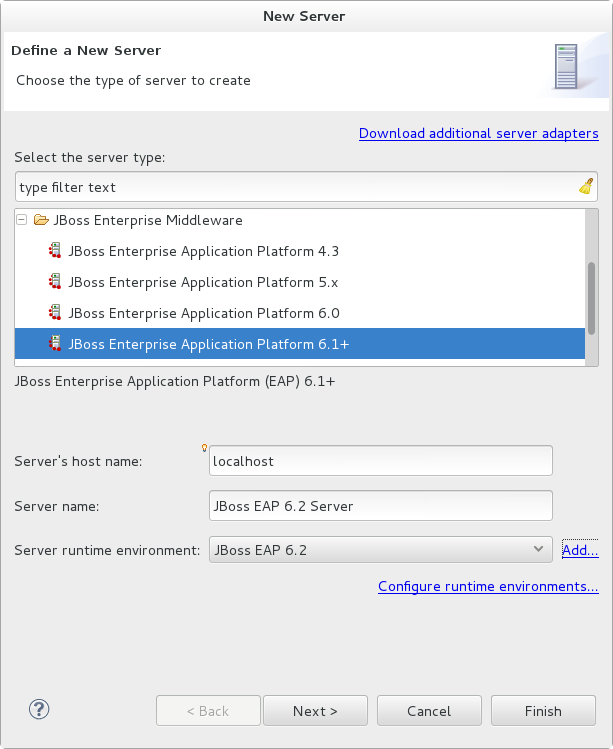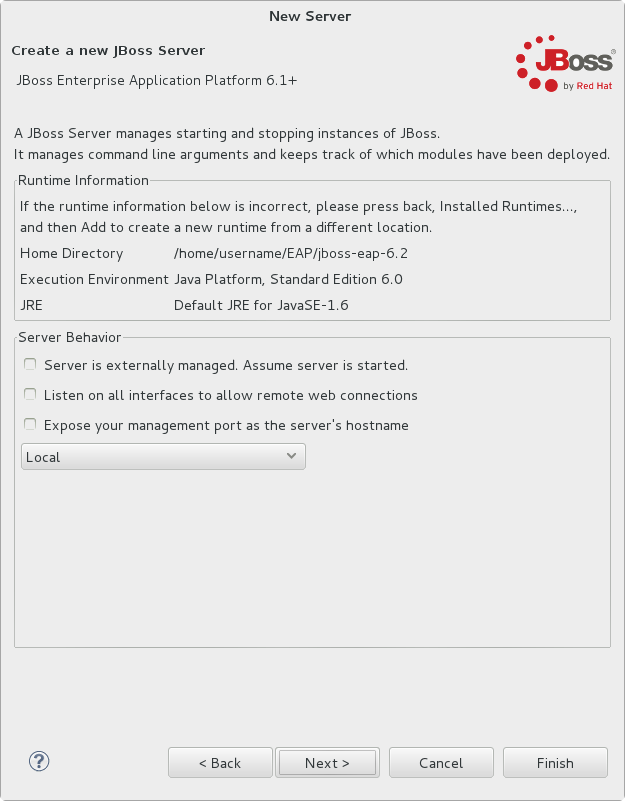-
Language:
English
-
Language:
English
Chapter 4. Post-install Instructions
4.1. Set Up the Development Environment
4.1.1. JBoss Developer Studio Installation Overview
This guide provides instructions for the simplest install path for JBoss Developer Studio. For complete JBoss Developer Studio installation procedures, see the Installation Guide for JBoss Developer Studio on https://access.redhat.com/site/documentation/en-US/Red_Hat_JBoss_Developer_Studio/.
4.1.2. Download JBoss Developer Studio
- Find Red Hat JBoss Developer Studio in the list.
- Click the Download Now button. You are prompted to save the ZIP file to a directory of your choice.
4.1.3. Install JBoss Developer Studio
- Open a terminal and navigate to the directory containing the downloaded
.jarfile. - Run the following command to launch the GUI installation program:
java -jar jbdevstudio-build_version.jar
Note
Alternatively, you may be able to double-click the.jarfile to launch the installation program. - Click Next to start the installation process.
- Select I accept the terms of this license agreement and click Next.
- Adjust the installation path and click Next.
Note
If the installation path folder does not exist, a prompt will appear. Click Ok to create the folder. - Choose a JVM, or leave the default JVM selected, and click Next.
- JBoss Developer Studio includes JBoss Enterprise Application Platform. If it was previously installed, choose No. Otherwise, choose Yes to install and configure it for use with JDBS.
- Review the installation details, and click Next.
- Click Next when the installation process is complete.
- Configure the desktop shortcuts for JBoss Developer Studio, and click Next.
- Click Done.
4.1.4. Start JBoss Developer Studio
To start JBoss Developer Studio, you can double-click on the desktop shortcut created during the installation, or you can start it in a command line. This topic describes how to start JDBS using the command line.
Procedure 4.1. Command to start JBoss Developer Studio
- Open a terminal and navigate to the JBoss Developer Studio installation directory.
- Run the following command to start the JBoss Developer Studio:For Linux:
[localhost]$ ./jbdevstudio
For Microsoft Windows:C:\JDBS_INSTALL_DIRECTORY > jbdevstudio.bat
4.1.5. Add the JBoss EAP Server Using Runtime Detection
These instructions assume this is your first introduction to JBoss Developer Studio 7.x and you have not yet added any JBoss EAP 6 servers. The procedure below adds the JBoss server using JBoss Server Tools runtime detection.
Procedure 4.2. Define a Server Using Runtime Detection
- Click Window→Preferences, expand JBoss Tools and select JBoss Runtime Detection.

Figure 4.1. JBoss Runtime Detection Pane
- Click Add.
- Select the directory containing the JBoss Enterprise Application Platform 6.2 installation and click OK. The directory is now scanned to find JBoss Enterprise Application Platform 6.2 application servers.

Figure 4.2. JBoss Enterprise Application Platform 6.x Found by Runtime Detection
- Be sure the jboss-eap-6.2 check box is selected and click OK.
- Click Apply to create a server for JBoss Enterprise Application Platform 6.2. Then click OK to close the Preferences window. The server is listed in the Servers view.

Figure 4.3. JBoss Enterprise Application Platform 6.2 Server Listed in Servers View
- The server is initially shown in stopped mode. The server starts automatically when you deploy a quickstart. To manually start the server, right-click jboss-eap-6.2 and click Start. After a short pause, the view switches to the Console view and shows the startup output of the server.
4.1.6. Add the JBoss EAP Server Using Define New Server
These instructions assume this is your first introduction to JBoss Developer Studio 7.x and you have not yet added any JBoss EAP servers. The procedure below adds the JBoss server using the Define New Server wizard.
Procedure 4.3. Add the server
- Open the Servers tab. If there is no Servers tab, add it to the panel as follows:
- Click Window → Show View → Other....
- Select Servers from the Server folder and click OK.
- Click on the link to create a new server or right-click within the blank Server panel and select New → Server.

Figure 4.4. Add a new server - No servers available
- Expand JBoss Enterprise Middleware and choose JBoss Enterprise Application Platform 6.1+. In the same dialog, click on the Add... link to define the new server runtime environment and click Next.

Figure 4.5. Define a New Server
- Click Browse and navigate to your JBoss EAP install location. Then click Next.

Figure 4.6. Add New Server Runtime Environment
- Review the new JBoss EAP Server definition and click Next to continue.

Figure 4.7. Review the New Server Definition
- On this screen you define the server behavior. You can start the server manually or let JBoss Developer Studio manage it for you. You can also define a remote server for deployment and determine if you want to expose the management port for that server, for example, if you need connect to it using JMX. In this example, we assume the server is local and you want JBoss Developer Studio to manage your server so you do not need to check anything. Click Next.

Figure 4.8. Define the New JBoss Server Behavior
- This screen allows you to configure existing projects for the new server. Because you do not have any projects at this point, click Finish.

Figure 4.9. Modify resources for the new JBoss server
Result
The JBoss EAP Runtime Server is listed in the Servers tab.

Figure 4.10. Server appears in the server list

